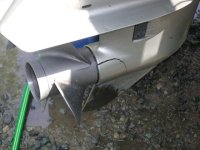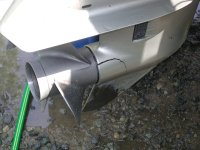Captains Cat
New member
OK C-Brats, I got a problem :cry . Hauled Captain's Choice recently because my bride was having surgery and we probably wouldn't get a chance to use the boat again this season. No problems at all noted in the water. When I hauled it, brought it home and ran each engine for about 10 minutes in fresh water (I have a tank that fits around each engine). No problems noted there either.
Imagine my surprise when I noticed this!!

I have a shop manual and it looks like if this crack had breached the oil sump, I would have had oil come out. I haven't drained the sump yet to see if it's "milky" as it says it will be if there's water in there, that's the next step. I can't remember hitting anything, the prop isn't dinged and the skeg isn't marked particularly. Not sure what could have caused this. The engine ran fine all season.
If I pull the prop shaft, I believe this could be "veed" out and welded, it's aluminum of course. Anyone have any ideas/recommendations?
Charlie
Imagine my surprise when I noticed this!!

I have a shop manual and it looks like if this crack had breached the oil sump, I would have had oil come out. I haven't drained the sump yet to see if it's "milky" as it says it will be if there's water in there, that's the next step. I can't remember hitting anything, the prop isn't dinged and the skeg isn't marked particularly. Not sure what could have caused this. The engine ran fine all season.
If I pull the prop shaft, I believe this could be "veed" out and welded, it's aluminum of course. Anyone have any ideas/recommendations?
Charlie

